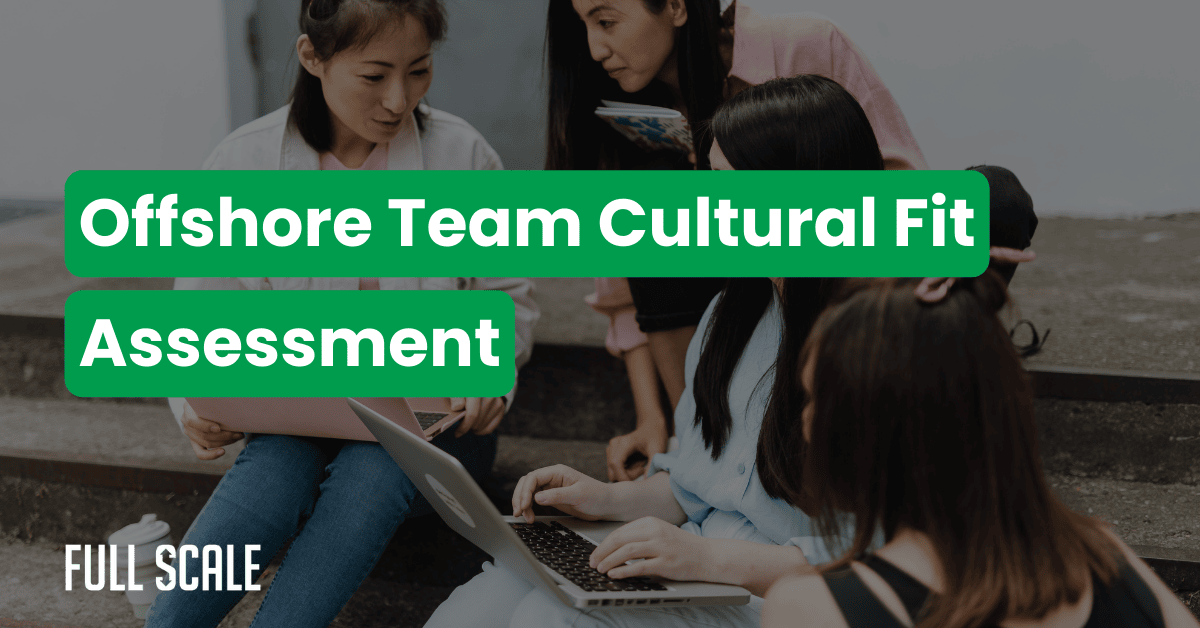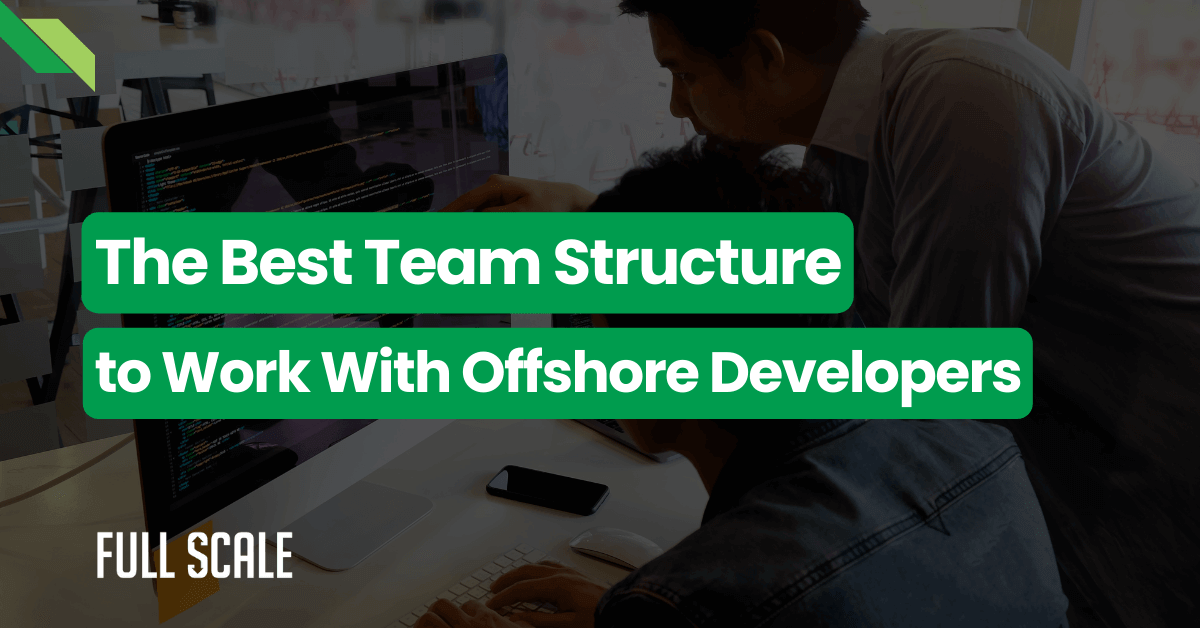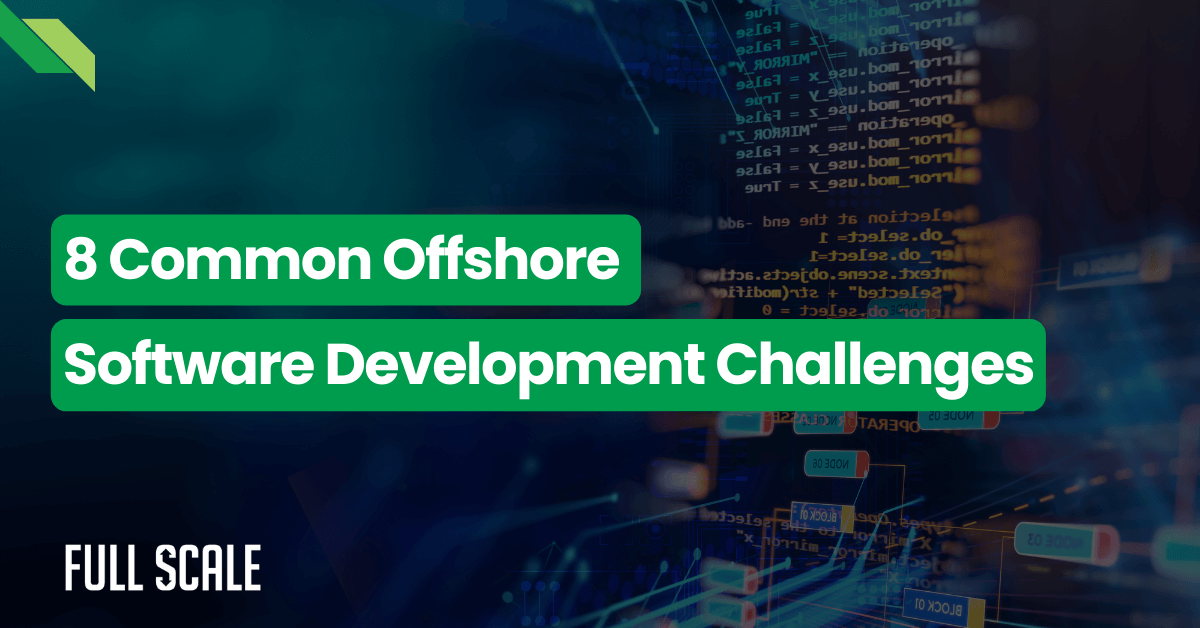Last Updated on 2025-11-27
Everyone asks: “Will offshore developers fit our culture?” Wrong question.
The real question is this: Does your team have a culture clear enough to integrate anyone into? This isn’t about whether Filipino developers understand American business culture. It’s about whether you can articulate what you value—and whether you’re willing to integrate, not just delegate.
Most offshore team cultural fit assessments fail because they measure stereotypes, not compatibility. If your local team can’t describe your engineering culture in three sentences, your offshore team won’t figure it out via telepathy.
Here’s the framework we use at Full Scale. And yes, we’ll tell you when you’re not ready.
What You'll Learn:
- Why most cultural fit assessments ask the wrong questions
- The 6-factor framework that predicts offshore success (with 95% accuracy)
- When to walk away—honest red flags we tell prospects about
- How to prepare your team for seamless offshore integration
- An interactive assessment tool to score your team's readiness
How do you assess if offshore developers will fit your culture?
Assess offshore team cultural fit by evaluating six operational factors:
- Communication clarity - Can you articulate expectations in writing?
- Autonomy expectations - Do you want thinkers or ticket-takers?
- Feedback culture - How do you give/receive constructive input?
- Integration investment - Will you treat them like team members?
- Process documentation - Can new developers understand workflows?
- Remote work maturity - Does your team work remotely well already?
Companies scoring 5-6 green flags on these factors see 95% offshore retention rates versus the 60% industry average.
What Offshore Team Cultural Fit Really Means (Not What You Think)
Offshore team cultural fit isn’t about nationality, time zones, or how “Americanized” developers act. It’s about aligning work styles, communication norms, feedback expectations, and decision-making processes. Companies with clearly defined cultures see 95% retention rates with offshore teams, compared to the industry average of 60%.
When evaluating offshore team compatibility, focus on operational alignment, not cultural stereotyping. The myth: “We need developers who work like Americans.” The reality: You need developers who work like YOUR specific team.
According to McKinsey’s 2024 hybrid work study, 58% of remote team failures stem from unclear communication expectations—not cultural differences. If you can’t onboard local developers smoothly, offshore developer integration culture challenges will amplify every existing weakness.

The visual above shows exactly what companies get wrong when evaluating offshore team compatibility. They focus on surface-level cultural indicators instead of operational compatibility.
Stack Overflow’s 2024 documentation research found that teams with strong documentation onboard new developers 3x faster. This matters even more for remote team cultural alignment.
The 6-Factor Cultural Fit Assessment for Offshore Developers
We’ve placed 500+ developers across 60+ tech companies. These six factors predict success or failure better than any vendor promise.
This cultural fit assessment offshore developers framework came from hard lessons. According to Gartner’s 2024 survey, 60% of remote worker failures trace back to inadequate onboarding and integration processes.
Factor 1: Communication Clarity
Can you write down what you need, or do you need a “quick 30-minute call” for everything? If it’s the latter, offshore will destroy you.
🟢 Green Flag: Your team communicates effectively asynchronously through Slack or documented specs. Code reviews are detailed. Requirements are written before development starts.
🔴 Red Flag: Everything requires synchronous explanation. You rely on whiteboard sessions. “I’ll know it when I see it” is your requirement methodology.
Factor 2: Autonomy Expectations
Do you want engineers who think critically, or ticket-takers who execute without question?
🟢 Green Flag: You want developers who challenge architectural decisions. You value their technical judgment. Problem-solving is encouraged.
🔴 Red Flag: You want someone who just follows orders. You get annoyed when developers ask “why.” You view them as code execution machines.
Factor 3: Feedback Culture
How do you give and receive constructive feedback with your current team?
🟢 Green Flag: Regular 1-on-1s with clear agendas. Direct but respectful feedback. Documented performance expectations.
🔴 Red Flag: No structured feedback loops. Passive-aggressive Slack messages. Surprise performance reviews.
Factor 4: Integration Investment
Are you willing to treat offshore developers like real team members, not invisible contractors?
🟢 Green Flag: They join daily standups and team Slack channels. They’re invited to the sprint planning. They see the product roadmap.
🔴 Red Flag: You want deliverables without relationship building. They should be “invisible” and just send code.
Factor 5: Process Documentation
Can a new developer understand your workflows without 47 Slack questions per day?
🟢 Green Flag: Documented Git workflows and code review standards. Architecture decision records exist. There’s an onboarding guide.
🔴 Red Flag: “We’ll explain as we go” is your documentation strategy. Everything lives in senior developers’ heads.
Factor 6: Remote Work Maturity
Does your existing team already work remotely effectively, or is everyone in-office?
🟢 Green Flag: You have successful remote or hybrid team members already. Async communication is normal. Remote workers aren’t second-class citizens.
🔴 Red Flag: Everyone’s in the office by requirement. Remote workers miss critical information. Office presence equals commitment.
| Your Score | Readiness Level | What It Means |
|---|---|---|
| 5-6 Green Flags | Ready Now | You're prepared for offshore integration. |
| 3-4 Green Flags | Need Prep Work | You're close but need 2-4 weeks of preparation. |
| 0-2 Green Flags | Not Ready Yet | Fix internal culture first. |
When We Tell Companies Offshore Won't Work
We turn down prospects regularly. Here’s when we say no.
I’ve watched companies fail at offshore integration. Every single time, the problem wasn’t the developers—it was the company’s lack of preparation.
Your Local Team Has High Turnover – If American developers quit after six months, Filipino developers will too. According to Gallup’s research, 70% of turnover stems from management issues.
You Can’t Explain What You Need – If you can’t onboard local developers smoothly, offshore will be chaos. Vague requirements won’t translate across any team.
You Want Them Invisible – “Just give me code” means you need project outsourcing, not staff augmentation. Wrong model.
Your Team Is Hostile to Remote Work – If in-office developers resent remote workers, they’ll resent offshore team members more.
You’re Doing This Only to Save Money – Cheap offshore fails spectacularly. Strategic offshore succeeds brilliantly. The difference between $25/hour disasters and successful $45-65/hour Full Scale teams is the integration model.
When Offshore Developer Integration Culture Thrives
Our 95% developer retention rate isn’t luck. Here’s what successful clients have in common.
Clear, Documented Culture – They can describe their engineering values in three sentences. Onboarding documentation exists and gets updated regularly.
Already Remote-Friendly – They have remote or hybrid team members who are fully integrated. Async communication feels natural.
Treat Offshore Like Team Members – Same Slack channels as local developers. Invited to all sprint planning and architecture discussions.
Patient With Integration – They expect a 30-day learning curve, not instant productivity. They invest time in relationship building.
Direct Access Model – Developers report directly to the CTO, not an account manager middleman. Learn more about how staff augmentation works.

One SaaS CTO told us: “Our offshore developers feel more integrated than our last three local hires.” Read more about our offshore development success strategies.
Deloitte’s 2024 Global Outsourcing Survey confirms staff augmentation models show 40% better retention than project-based outsourcing.
How Full Scale Approaches Company Culture Offshore Hiring
Our approach to cultural fit assessment offshore developers differs fundamentally from traditional outsourcing agencies.
Full Scale vs. Traditional Offshore Agencies
| Factor | Traditional | Full Scale |
|---|---|---|
| Cultural Fit | ❌ Generic | ✅ 6-factor framework |
| Communication | ❌ Middlemen | ✅ Direct access |
| Retention | ❌ 60% average | ✅ 95% retention |
| Contracts | ❌ 6-12 month lock-in | ✅ Month-to-month |
| Assessment | ❌ "Everyone's ready" | ✅ Honest evaluation |
Why Partner With Full Scale
We Vet for YOUR Culture – We learn your specific communication style and work preferences. We match developers based on operational compatibility.
Staff Augmentation = True Integration – Direct reporting to you, not account managers. Learn about why staff augmentation works better.
We’re Honest When It Won’t Work – If your score is low, we’ll tell you to fix your culture first. Read about our rigorous vetting process.
Our Retention Data Proves It – 95% annual retention vs. 60% industry average. See our retention strategies.
Transparent Pricing – Senior developers: $45-65/hour. No hidden fees. Full details at fullscale.io/pricing.
Interactive Cultural Fit Assessment Tool
Answer six questions honestly. Get your readiness score instantly.
6-Factor Offshore Readiness Assessment
Discover if your team is ready for successful offshore integration
Key Takeaways
-
Core Principle
Cultural fit ≠ nationality
Operational compatibility matters, not geographic origin
-
Success Factors
6 factors predict success
Communication, autonomy, feedback, integration, documentation, remote maturity
-
Proven Results
95% retention is achievable
With proper cultural assessment and integration practices
-
Self-Assessment
Honest self-assessment matters
Fix internal culture first if you score 0-2 on readiness factors
-
Timeline Expectations
30-90 day integration timeline
Expect a learning curve, not instant productivity from day one
Score 4+ Green Flags?
Let’s discuss your team’s needs and integration timeline. No sales pitch. Just an honest assessment.
The actual difference is communication directness. Western teams prefer blunt feedback while Filipino culture values harmony and indirect communication. Successful offshore team cultural fit happens when both sides adapt.
Expect 30 days for basic integration and 90 days for full productivity. Month one is learning systems. Month two is a meaningful contribution. Month three is full velocity.
Yes, if you can articulate it clearly. The question isn’t whether they can understand—it’s whether you can explain it. Document your values and processes.
The Philippines is 12-16 hours ahead. Most clients use a 2-4 hour daily overlap. Filipino developers work evening shifts to align with US afternoon, creating productive async cycles.
Senior developers range $45-65/hour depending on experience. No hidden fees. Month-to-month after 3 months.

Matt Watson is a serial tech entrepreneur who has started four companies and had a nine-figure exit. He was the founder and CTO of VinSolutions, the #1 CRM software used in today’s automotive industry. He has over twenty years of experience working as a tech CTO and building cutting-edge SaaS solutions.
As the CEO of Full Scale, he has helped over 100 tech companies build their software services and development teams. Full Scale specializes in helping tech companies grow by augmenting their in-house teams with software development talent from the Philippines.
Matt hosts Startup Hustle, a top podcast about entrepreneurship with over 6 million downloads. He has a wealth of knowledge about startups and business from his personal experience and from interviewing hundreds of other entrepreneurs.




